by Xinhua writers Wang Jingzhong, Ling Guangzhi, Xu Ruiqing
SANSHA, Hainan, May 22 (Xinhua) -- Anyone lucky enough to stroll on the white sands of Nanshazhou, a tiny islet in the middle of the South China Sea, should not be surprised to come across fragments of ceramics, hundreds of years old.
Located in the east of the Xisha archipelago, part of China's southernmost city of Sansha, the unspoiled, uninhabited island is protected by a massive reef which only allows the smallest of boats to pass at high tide.
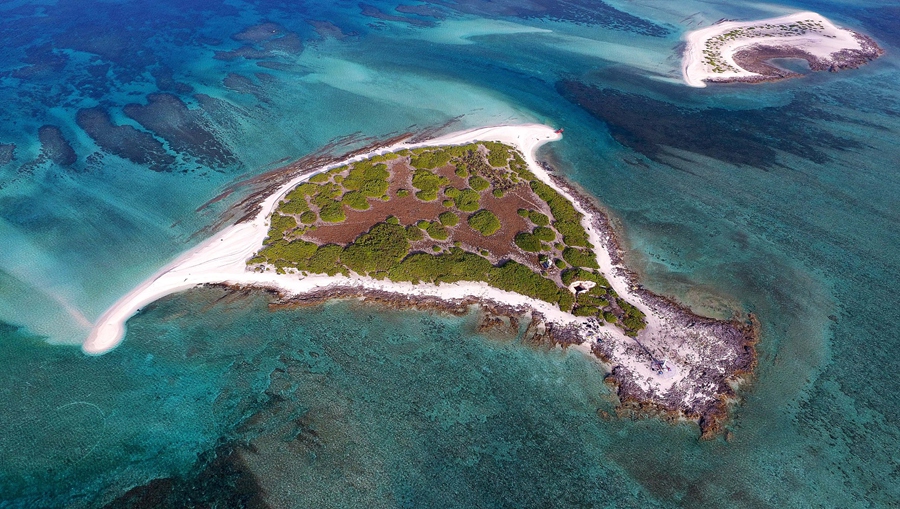
The Nanshazhou of Xisha Xuande Islands is a tiny islet in the middle of South China Sea. (Xinhua/Guo Cheng)
Fragments of ancient porcelain are scattered along the beach. Snorkelers can easily find more among the coral in the crystal clear waters.
"Made in the era of Chenghua" read the characters on the bottom of one broken blue and white porcelain bowl. Chenghua, the eighth Ming emperor, reigned from 1464 to 1487.
It was in the Ming Dynasty that the blue and white porcelain that characterizes "china" for so many people was fully developed and became one of China's -- or indeed any nation's -- first mass exports.
Such pieces of sea-washed china can be found on almost every island in the Xisha archipelago, mostly washed ashore from sunken ships that once plied the ancient maritime silk road from China through Southeast Asia, onward across the Indian Ocean to the Arab world and beyond.
The South China Sea was the heart of all this frenzied traffic and trade. Today it would be called a "hub," but not just of trade. The islands and ports of the South China Sea were washed by a vast, vibrant tide of cultural and scientific exchange, a huge marketplace where ideas, religions, philosophies, technology and techniques competed and cooperated to drive civilization forward.
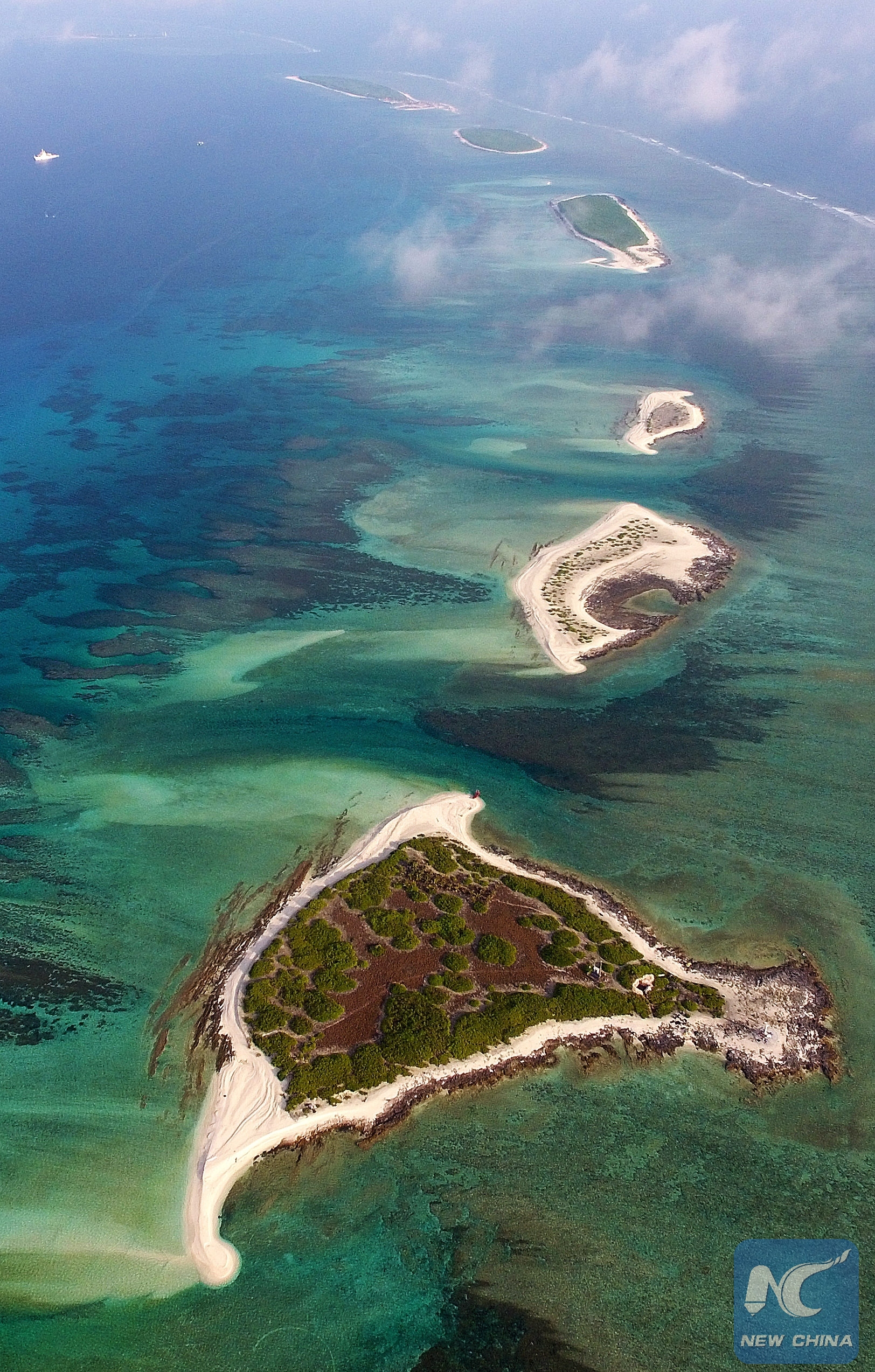
The Qilianyu Islands of Xisha Xuande Islands are composed of seven islands in South China Sea. (Xinhua/Guo Cheng)
LOOKING SEAWARD
In his definitive speech at the May 14 opening ceremony of the Belt and Road Forum for International Cooperation in Beijing, President Xi Jinping spoke of the Belitung shipwreck in Indonesia as testament to the timeless friendly engagement of nations whose seaborne trade comprised the ancient maritime silk route.
The ship's remarkable cargo consisted of outright treasure in the form of gold and silver, but also more than 60,000 pieces of ceramics produced in China during the Tang Dynasty (618-907).
No one knows for sure exactly where the Middle Eastern ship, or dhow's voyage began, nor for where it was ultimately bound, but what is certain is that its cargo is early proof of the strong trading links between China, Southeast Asia, and the Middle East.
Starting from China's coastal cities, such as Guangzhou and Quanzhou, the rise of maritime trade began during the Qin and Han dynasties more than 2,000 years ago, and came to full flower in the Tang and Song dynasties around a thousand years later.
Silk, porcelain, tea, bronze, brass and iron were ferried out of China, while spices, exotic plants and animals and other rare treasures were carried back.
In the early period, ships crossing the South China Sea would sail along the east coast of the Indochina Peninsula but as shipbuilding and navigational techniques improved, seaways were opened through the islands of Xisha and Nansha in the middle of the sea, cutting hundreds of miles and many days off the journey, said Zhang Yiping, a history professor with Hainan Normal University.
As journey times and distances fell, the risks of an already hazardous journey rose. With rising risk, of course, came rising returns for the skillful and lucky. To this day the seas around the Xisha and Nansha islands are prone to stormy weather. Hidden rocks and reefs lie in wait for the inexperienced navigator. Many a sailor has found a watery grave and many a precious cargo has been lost to the depths.
RAISING THE PAST
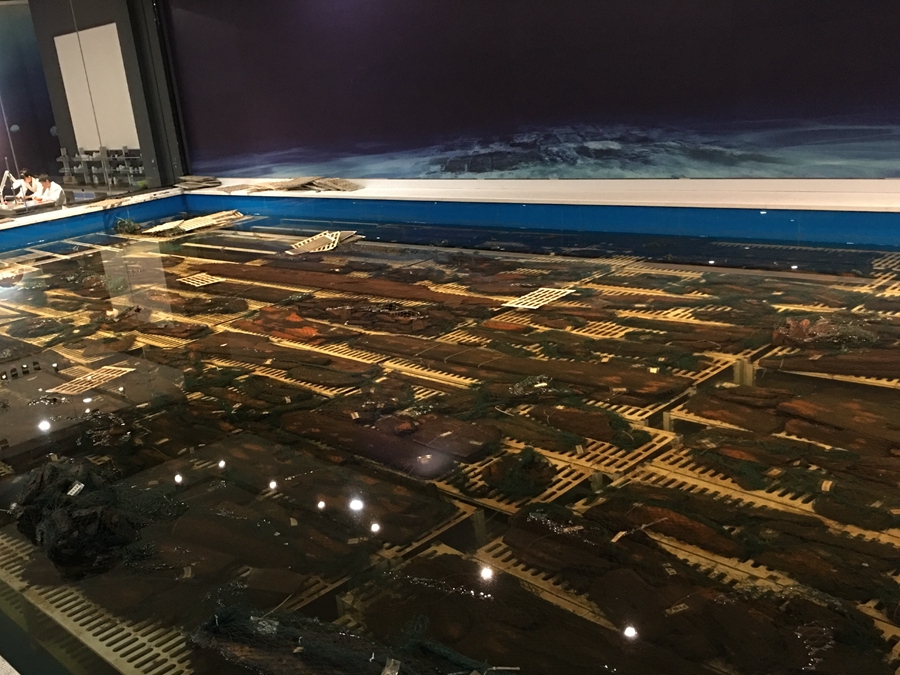
Planks from the hull of an ancient ship are being desalinized. (Xinhua/Wang Jingzhong)
In a large indoor tank in Hainan Provincial Museum in Haikou, about 500 planks from the hull of a trading vessel dating back to the Southern Song Dynasty (1127-1279) are being desalinized.
Working professionally, museum staff take each timber from the tank one by one. Each item is photographed and scanned as part of an ambitious project to build a virtual image of the ship.
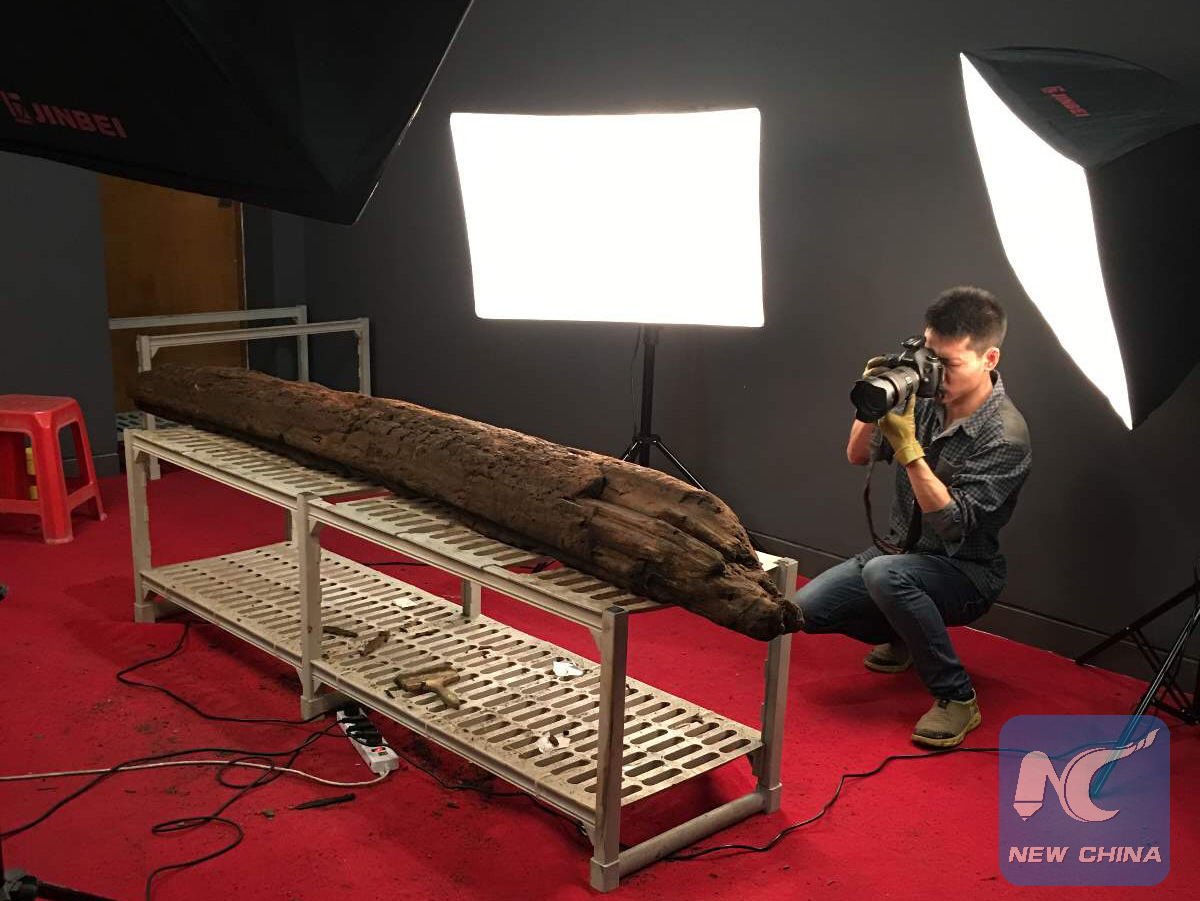
A worker photographs a timber in the museum. (Xinhua/Wang Jingzhong)
The ship was excavated in Huaguang Reef in the west of Xisha Islands in 2007. Archeologists believe that the fully-laden ship was probably on its way to Southeast Asia and sank through a combination of an unusually high tide and incompetent navigation.
The ship, 20 meters long and six meters wide, is a type of "Fu-chuan," said Bao Chunlei, the head of the team working on the reconstruction project.
The word "Fu" refers to Fujian Province, where the ships were built, and "chuan," is the Chinese word for boat. Through a variety of cognates -- perhaps the Portuguese "junco," or the Malay word "jong" -- this kind of sharp-bottom seafaring ship became known in English as a junk.
During the Song Dynasty, Fu-chuan were the very best vessels of their time and the premier vehicle of ocean-going trade in the region.
More than 10,000 artifacts were recovered from the ship along with the timbers, including around 7,500 porcelain bowls, 700 plates and 2,500 lady's face-powder boxes.
"Ironware was also retrieved from the ship, but it is difficult to tell exactly what these items were due to serious corrosion," said Bao.
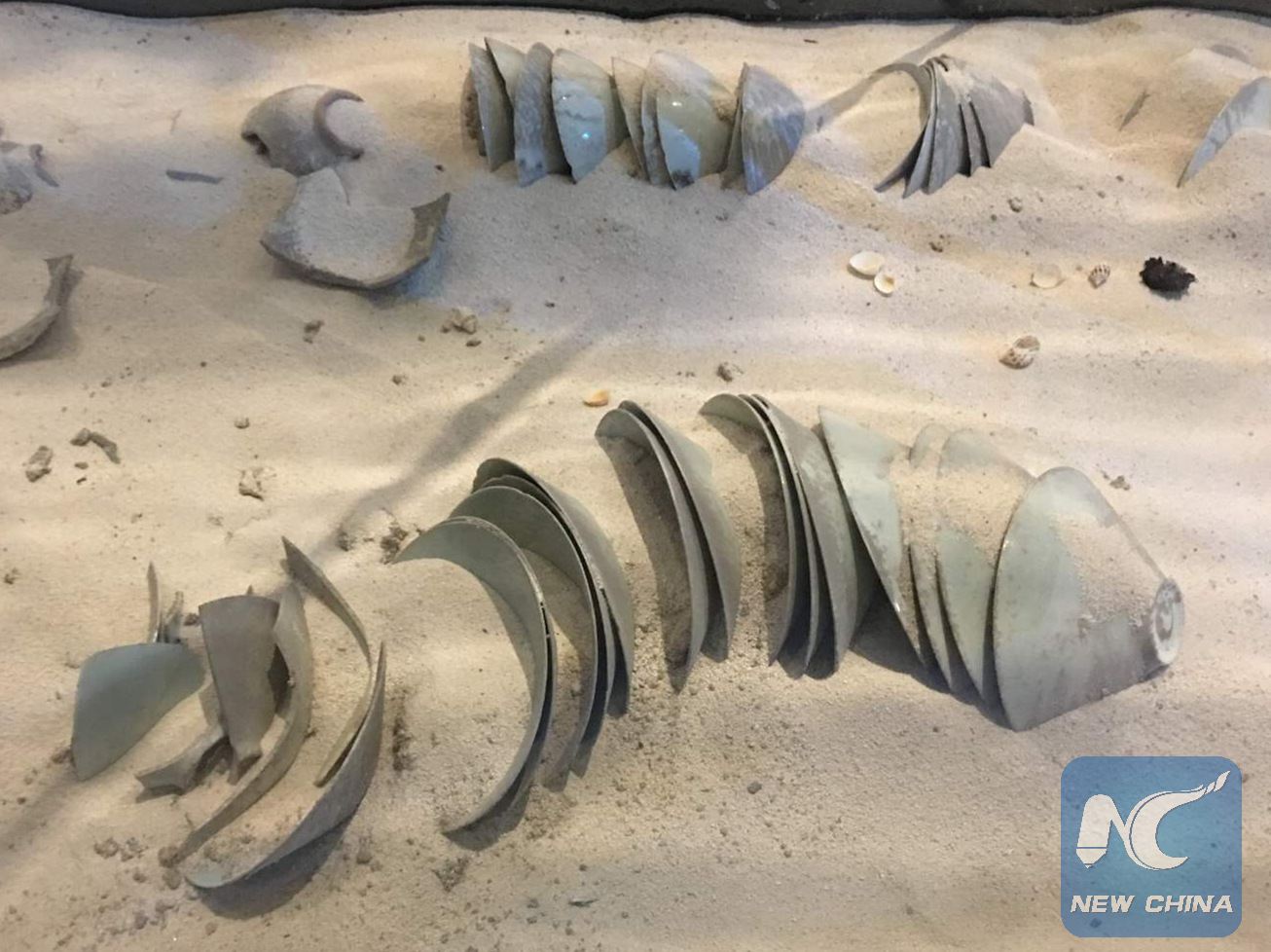
Thousands of porcelain bowls and plates recovered from the sunken ship are now displayed in the museum. (Xinhua/Wang Jingzhong)
"When we have completed our desalinization and repair work on the wreck we hope to reconstruct and restore the vessel, so that it can be put on display for the public," he said.
Since 1996, Chinese archeologists have located more than 120 such shipwrecks at depths of between 20 meters and 60 meters in the South China Sea. Hundreds, maybe thousands, more lie at greater depths.
Among all the master mariners to sail the seas of antiquity, eunuch Zheng He, a Ming Dynasty explorer and diplomat, is perhaps the best remembered.
In the early 15th century, the Chinese Muslim navigator made seven voyages to the Western Seas, as the Indian Ocean was then known, sharing the latest Chinese technology, making maps, and helping settle territorial disputes while putting down piracy all along the way.
Temples in his memory can still be seen in many parts of Southeast Asia.
21st CENTURY MARITIME SILK ROAD TAKES SHAPE
In the autumn of 2013, first in Kazakhstan and then in Indonesia, President Xi proposed the building of the Silk Road Economic Belt and the 21st Century Maritime Silk Road.
The Belt and Road Initiative will be a trade and infrastructure network connecting Asia with Europe and Africa along and beyond the age-old trade corridors.
Four years on, over 100 countries and international organizations are involved. Close to 70 countries and international organizations have signed agreements with China on Belt and Road cooperation, including most of the countries on the South China Sea.
"Through the initiative, we hope we can find new driving forces for growth, create a new platform for global development, and re-balance economic globalization," Xi said at the forum, attended by heads of state and government from across the world, including those from Vietnam, Indonesia, the Philippines, Cambodia and Malaysia.
During the two-day event, these Southeast Asian countries reached a number of agreements with China on trade, infrastructure, maritime affairs and environmental protection.
"The ancient silk routes thrived in times of peace, but lost vigor in times of war," said Xi. "We should foster a new type of international relations."
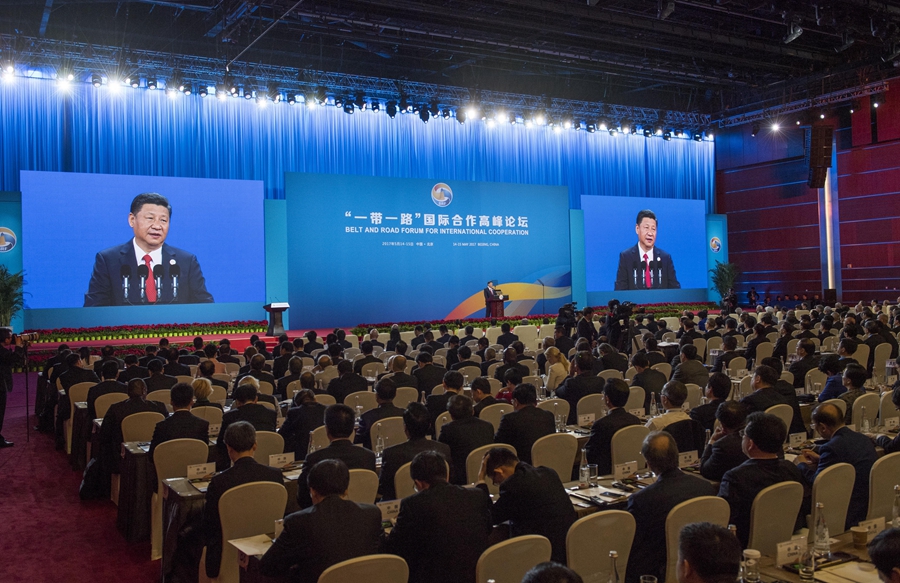
Chinese President Xi Jinping delivers a keynote speech at the opening ceremony of the Belt and Road Forum for International Cooperation in Beijing on May 14, 2017. (Xinhua/Li Xueren)
SAFE NAVIGATION: CLOSE COOPERATION
Safety of navigation is key to sustaining the 21st Century Maritime Silk Road.
Sea traffic in the South China Sea is now immeasurably greater than in bygone days. An estimated 5 trillion U.S. dollars of goods are transported through the area each year, including more than half the world's annual merchant tonnage and a third of the world's maritime traffic.
Despite great improvements in navigational technology, ships on the South China Sea still face grave dangers posed by typhoons, cyclones, rapid oceanic currents and hidden rocks.
"The weather is changeable and can be hard to predict, but we try our best to provide accurate forecasts," said Chen Shaojian, deputy director of the meteorological bureau of Sansha, the city that manages Xisha, Nansha and Zhongsha islands.
In 2012, the bureau set up a radio station on Yongxing Island, the city seat of Sansha, broadcasting weather forecasts ten times a day. Information collected by the bureau is shared with the international community through the World Meteorological Organization.
"It is difficult to foresee short-term extreme weather conditions," he said, explaining that with observation stations so few and far between, especially in Nansha Islands, there is nowhere near enough coverage of vast areas of the South China Sea.
Safe navigation demands efficient rescue operations to ensure the safety of ships and sailors in peril. To this end, Sansha's maritime search and rescue center provides 24 hour rescue cover.
"When we receive an emergency call, we coordinate all nearby ships to assist with the rescue," said Zou Xianzhi, executive deputy director of the center.
Zou recalled that in August 2016, the center received an emergency call from a Vietnamese boat in the Xisha area, saying that a sailor was badly injured. A helicopter from Sanya on Hainan Island, more than 300 km away, headed for the ship and airlifted the wounded sailor to hospital.
Over the past five years, the center has coordinated the rescues of more than 1,300 people in 69 emergencies, she said.
"Our major challenge is the great distance involved," said Zou, acknowledging that the center does not have vessels with the capacity of reaching Nansha Islands, some 800 km away.
Each year, about 70,000 vessels traverse the waters around Nansha Islands, 80 percent of the maritime traffic in the South China Sea. The number of ships in the South China Sea is expected to surge with the growth of trade along the 21st Century Maritime Silk Road, Zou said.
"We need bigger vessels to meet our search and rescue obligations," said Zou. "We need closer cooperation with our neighbors to make the 21st Century Maritime Silk Road a safe place for sailors the world over."
(Xinhua correspondents Miao Xiaojuan, Tu Chaohua, Zhao Yeping, Dai Chao contributed to this story.)
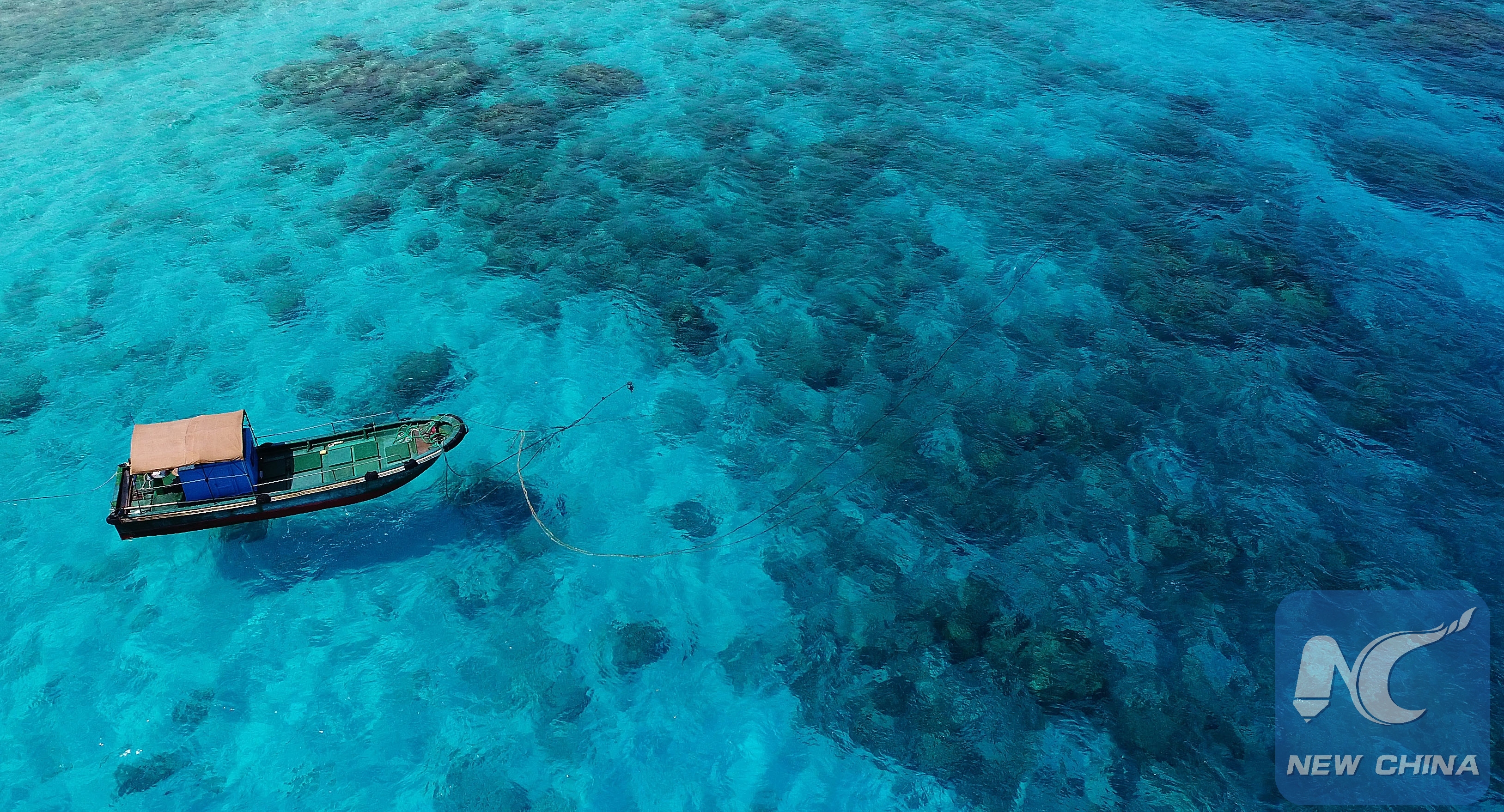
A boat sails near the Ganquan Island of Xisha Yongle Islands in South China Sea. (Xinhua/Guo Cheng)

